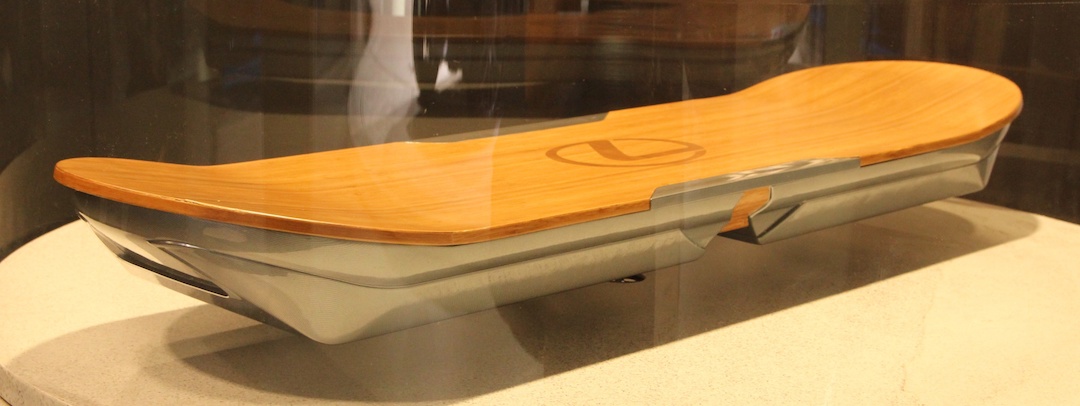Superconductors
Claimed by Andrew Huot Fall 2019 Superconductors are materials that can conduct electricity (or current) perfectly, meaning that no energy is lost to electric resistance and there is no magnetic flux fields expelled when they carry a current. In order to understand the significance of this property of superconductors and see some examples, it's important to understand what electrical resistance is and why it can become a problem when moving energy around. Superconductors can also prevent the prescience of all magnetic fields on the inside of the material itself, known by the name of the Meisner effect.
Introduction to Resistance
Electric resistance is a property of all metals and conductors except superconductors. It is the reason why electronics deteriorate with use, in part due to the heat generated when current is passed through a conductor with electric resistance. This is happens because the resistance of the conductor which the electric current is trying to cross, resists the flow of current and in this resistance it generates heat from the “friction” of the current against the resistance.
In essence, electric resistance refers to how difficult it is for electrons to pass through a conductor. Where analogically, resistance behaves like the friction force found through classic Newtonian physics in mechanical systems, because it removes energy from what would without its presence be essentially a perfectly closed system. It's easy to think about electric resistance in the same way as you would water flowing through a pipe, thinking of the water as the current and obstacles in the pipe as the resistance of a conductor, where the amount, and size of the obstacles relates to how much electric resistance there is; with a higher obstruction of the flow of water in the pipe, relating in this analogy to a higher electric resistance. An important concept to understand superconductors is the Meisner effect.
In a conductor and current situation, electrons flow between metal ions towards their endpoints. How well they stick to these electrons is a measure of their resistance relating back to the friction analogy. Depending on the material that the conductor is made off, the metal ions will hold onto the electrons more or less, and cause them to flow through at different rates. The more tightly held the electrons are on their way to the end of the wire, the more energy they lose, in part as heat, as a result. But, in a superconductor, this is eliminated and the electrons are able to go from their start points to their endpoints without losing energy. Unfortunately, most superconductors require temperatures that get very close to absolute zero, which is extremely difficult to maintain even in an environment as controlled as a lab.
About Superconductors
When you lower the temperature of a metal, its resistance decreases. This principle can be demonstrated by bringing a small circuit with a bulb slowly down in temperature, which because of ohm's law, would result in the bulb beginning to glow brighter; as there is a greater amount (a higher magnitude) of current flowing through it. That is until the circuit would heat itself back up and thus nullify the current increase allowed by lowering the circuits temperature in the first place. By lowering the temperature, the resistance is lowered which when V=IR is taken into account, lowering R (resistance) causes a raise in I (current), which ultimately leads to a rise in brightness.
For most materials, decreasing their temperatures decreases their resistance in such a way that when taking them to absolute zero (0°K or close to it) it causes the materials to experience a resistance decrease that goes towards zero. A special case of this phenomena are materials known as superconductors which are able to lose all electric resistance at varying temperatures, although most require extremely low temperatures to behave as proper superconductors. Superconductivity has been found to occur in many metallic elements and also inter metallic elements, but is reserved to these two material groups. There are a few metals that are not superconductors including Li, Na, and K. Interestingly, superconductivity is unique because unlike many other physical phenomena (ionization potential, electro-negativity, etc.) it is not relatable to the periodic table. Even more surprising, superconductivity doesn't correlate with conductivity!
What is happening at the molecular level is that the atoms vibrate slowly enough so as to diminish their attraction of the electrons that pass by them in close proximity, and the attractions are minimized to the point where electrons are able to flow through the conductor with no resistance.
In order for a conductor to be a superconductors they must be within a certain range, below their critical temperature and critical magnetic field. If it becomes warmer than the highest critical value, or the magnetic field is stronger than the allowed value, they might be very good conductors, but not superconductors. Closely correlated with the
Much like running through a tunnel where a group of people have filled it and lined up to high five a runner which acts like an electron, and the people trying to high five the runner are the atoms in the wire. When the temperature is lowered and it becomes very cold, the people no longer want (or can) high five the runner (electron).
Critical Temperature often labeled as Tc, or critical temperature. This is the temperature at which the superconductor needs to be beneath in order for it to exhibit these behaviors. Some superconductors are more useful than others because they have higher critical temperatures. To see a table of these, click here. Obviously, some have more practical applications than others because of these temperatures.
Critical Magnetic Field- often labeled as Hc. A superconductor also won't exhibit any of its properties if a magnetic field is greater than a certain value, called the critical magnetic field, even at absolute zero. Superconductors that have higher critical temperatures usually have higher critical magnetic fields, but the correlation isn't exact.
Meisner effect- unique to superconductors, this is the ability to cancel out all external magnetic fields on the inside of the superconductor below the critical magnetic field. Below the critical magnetic field, the superconductor can create mini currents on its surface to eliminate these in the same way that a block of metal can automatically generate an electric field to block out an external electric field, making its net electric field zero. Basically, you could never be asked to do a hall effect problem with a superconductor!
There are two types of superconductors, cleverly named Type 1 and Type 2. Their classification is based on how they break down once their critical magnetic field is reached. Under the critical magnetic field and critical temperature, they all behave similarly.
Type 1- The first type of superconductor is one that has been experimented with the longest. When they are raised above their critical magnetic field, they simply stop being superconductors. Most commonly, these are pure metals like Aluminum and Mercury.
Type 2- when at the critical magnetic field, type 2 superconductors will slowly lose their properties, rather than just completely becoming normal conductors like Type 1. When they break down, they form mini currents and somewhat exhibit the Meisner effect, having a mix of properties between conductors and superconductors. They exhibit 2 critical Magnetic fields, Hc1 where they are no longer complete superconductors, and Hc2 when they are no longer partial superconductors. These superconductors aren't fully understood and need to be further researched.
History of Superconductors
1911- Superconductors were first discovered by Heike Kamerlingh Onnes, a Dutch Physicist. He experimented with mercury, a type 1 superconductor, below 4 degrees celcius.
1935- Type 2 superconductors were first discovered by Leb Shubnikov.
1950s- Lev Lendau and Vitaly Ginzburg were the first to theorize about why type 2 superconductors existed.
1972- The basic theory of superconductivity was published by John Bardeen, Leon Cooper, and John Schrieffer. They went on to win a nobel prize.
1986- Karl Muller and Johannes Bednorz realized that superconductors didn't have to be at absolute zero, and found a way to create one that operated at 40 degrees kelvin.
2015- We acheived the greatest record of superconducter temperature at 203 degrees kelvin, but under high pressure. We've been using pressure to cheat the temperature requirements for a while. This was the work of A. P. Drozdov,M. I. Eremets,I. A. Troyan, V. Ksenofontov, and S. I. Shylin.
Applications of Superconductors
Large Hadron Supercollider- The Large Hadron Supercollider runs between France and Switzerland, and is used to experiment with fundamental particles and other complicated stuff. It uses superconductors to accelerate particles to super high speeds so that they can be observed. For more information about the LHC.
Photo curtesy of https://commons.wikimedia.org/wiki/File:CERN_LHC_Tunnel1.jpg
‘’’Transportation’’’- through a phenomena called Quantum Levitation, superconductors can be used to create an object that can levitate, where the superconductor floats above a magnet by the “cushion” generated by the magnetic field interacting with the superconductor. This capability of superconductors could be used for futuristic transportation devices like hoverboards, or a proposed theoretical super efficient railway.
Photo curtesy of https://commons.wikimedia.org/wiki/File:Lexus_Hoverboard_mockup_at_IAA_Frankfurt_2015_IMG_9297.jpg
‘’’Energy Storage’’’- current in a in a superconducting loop could theoretically never dissipate, so technology equipped with superconducting material energy storage could never run out of power, but continue to be charged. This could allow for a drastic reduction in energy usage around the world.
Medical devides- superconductors have possible uses in medical devices ranging from MRI to NMR machines, both of which can be used in modern medicine to help diagnose various medical conditions such as cancer and discovering early signs of distress from a pregnancy. Superconducting magnets are used to form a strong magnetic field around a patient, and using radio frequencies and very powerful magnetic fields in combination with sophisticated computer software allows for the detailed imaging of soft tissues and bones in a non invasive procedure.
Energy Transport - However, at present, and for the foreseeable future, high-temperature superconducting wires cannot compete economically and technically with low-temperature superconductors (Watson 1999). Novel approaches to overcome the current limitations of high-Tc materials, such as the application of flux tubes, has been proposed by Watson and Bolt (2000).
Quantum Computing - Quantum computing is cited by many experts to be one of the most impactful areas of technological development in the intermediate future. As traditional computers begin to approach limits in the coming years in regards to how many transistors can fit in a smaller and smaller area, possibly spelling the end to Moores Law, experts are looking to quantum computers to fill the gap. Companies such as Google, IBM, Microsoft, and Intel as well as various universities (shout out to GT!) Most quantum computers rely on superconductors to perform their operations. Quantum computers rely on quibits in a similar manner to how classical computers rely on bits. A quibit is similar to a bit in the sense that it can take on two distinct states, yet dissimilar because of superposition where both states can exist simultaneously. Google last month (October 2019) demonstrated quantum supremacy for the first time, meaning a quantum computer outperformed the any classical computer for a specific application.
[[File: /Users/andrewhuot/Desktop/20180405-ibm-q-quantum-computer-02.jpg]
Connectedness
I'm a chemical engineer and love the idea of coming up with solutions that will help out our future when it comes to life on earth. Superconductors could be the solutions to lots of problems having to deal with energy, which really excites me. I also love chemistry and know a lot about superconductors from a chemistry perspective, but wanted to add some physics knowledge to my collection.
See also
If you want to learn more about how semiconductor devices work make sure to check the physics wiki, as well as to further read about what resistivity is and how it affects conductivity.
Further Reading
Futuristic Technology and Superconductors
http://www.osti.gov/scitech/biblio/6775476
https://journals.aps.org/rmp/abstract/10.1103/RevModPhys.36.31
List of corresponding Superconductors and their Tc and Hc constants
https://books.google.com/books?hl=en&lr=&id=4RC_XxG9UX4C&
External links
https://www.youtube.com/watch?v=pPBsxylW2Z0
https://www.youtube.com/watch?v=ZhmsurWhj-o
https://www.youtube.com/watch?v=Ws6AAhTw7RA
https://www.youtube.com/watch?v=ZlQUW_Gr3WU
https://www.youtube.com/watch?v=bU4UUxJPEc8
https://www.youtube.com/watch?v=IHoSMj3BpzM
A Computational Model
Computer model of a superconductor of type 2 https://www.youtube.com/watch?v=MFapXJy7ASU
References
https://home.cern/about/engineering/superconductivity
http://www.superconductorweek.com/what-is-superconductivity
http://hyperphysics.phy-astr.gsu.edu/hbase/Solids/scond.html
http://physics.about.com/od/particleaccelerators/a/largehadron.htm
https://home.cern/about/engineering/superconductivity
https://en.wikipedia.org/wiki/Superconductivity
https://en.wikipedia.org/wiki/Electrical_resistance_and_conductance
http://www.livescience.com/51877-superconductors-new-temperature-record.html
--by Andrew Huot Fall 2019



